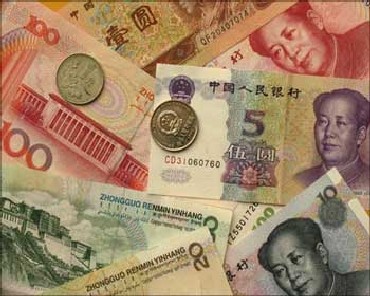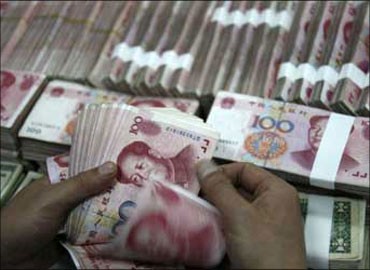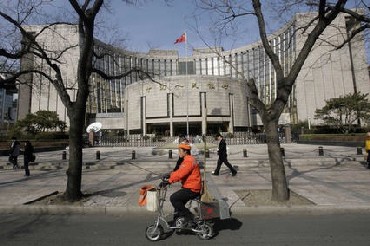Photographs: Reuters Zorawar Daulet Singh
Ever since the global economy turned south, Beijing's planners have been credited with a level of skill and fortitude not seen in the politically deadlocked West. China's massive stimulus of nearly 15 per cent of its GDP was seen as salvaging global demand when few economies possessed the fiscal resilience to step up to the plate.
But, this was a holding operation premised on the expectation that OECD consumer demand would resume its pre-crisis path. This has not happened. It is becoming apparent that China's macroeconomic edifice is not nearly as robust and sustainable as mainstream economists had previously presumed.
Since the 1990s, China's growth has been driven by an urban-oriented capital-intensive investment strategy sustained by the export-oriented complex on its east coast.
As China's household demand has been systematically repressed to channel savings into the banking system to finance high investments, the existence of an external outlet to absorb its surplus production has always been necessary.
...
Is China really losing its sheen?
Image: Chinese currency.Thus, two pillars - high investment and massive exports - are vital to China's economy to maintain its record growth rates without letting the process become unsustainable.
Such a model naturally required economies that could absorb China's production. The US and EU together absorb 40 per cent of China's export demand.
The 2007-08 global crisis and attendant slowdown in western consumer demand weakened one of the pillars that supported China's economy.
Beijing unleashed a state-led investment stimulus by releasing massive credit to nearly $1.5 trillion in 2009 and 2010. Fixed-asset investments financed through the banking system drove an infrastructure boom across provinces.
...
Is China really losing its sheen?
The empirical results were impressive. China had staved off a hard-landing and its 9 per cent-plus growth rates were defying global trends, which was astonishing given the extent of its huge dependence on international commerce.
So, how was China growing so fast when its main export markets were in a slump? From 2000-2010, investment accounted for 55 per cent of GDP growth, and this figure went upto 70 per cent in the post-crisis phase. Clearly, there is an institutional dynamic that produces overinvestment in China.
Since the 1994 tax reforms, the fiscal balance of power in China led to a situation where provincial share of total tax revenues fell to 45 per cent, while its expenditure commitments remained as high as 77 per cent of total government spending.
...
Is China really losing its sheen?
This revenue-expenditure mismatch compelled provinces to find new sources of finance. By the early 2000s, land, the ultimate state resource, became the indispensable income stream, as local governments began selling land for residential developments to fund state investment.
By 2010, $464 billion or 70 per cent of total local government revenues were accounted for by land sales. In fact, much of China's infrastructure investment is financed by this commercialisation of land.
To be sure, the original impetus for China's growth in the early 1980s was driven by its decentralised structure where provinces lacking not more than perfunctory support from Beijing were literally competing with each other to survive and flourish.
...
Is China really losing its sheen?
Image: Chinese architecture style dragon head is seen as the moon rises at Jiayuguan Pass, ChinaPhotographs: Jason Lee/Reuters
But as the reform years have gone by, China's bottom-up entrepreneurialism has given way to a crony-capitalist nexus between provinces and property developers that can no longer be restrained by Beijing.
There are now vested interests that thrive on building infrastructure and capitalising on the land conversion bonanza. And because provincial investment decisions are not disciplined by the market as asset ownership remains with the state, provincial officials rarely worry about the systemic overcapacity they create.
Beijing's 2008 counter-cyclical stimulus triggered precisely this political economy dynamic.
The provinces merely needed a nudge from Beijing, and, once money supply was unleashed via the centralised banking system, the investment boom took a life of its own.
...
Is China really losing its sheen?
Image: Central Bank of China.Photographs: Reuters
The quantum of investment stock is so high that in some sectors such as steel, highways, railroads, airports, China's capacity has reached a level that cannot be absorbed even in the medium term.
The consequences of China's hyper-investment are becoming apparent as Beijing's twin growth pillars investment and exports are losing their punch. The result has been a massive build up of debt, and, oversupply in several sectors, especially in real estate and infrastructure, which China's households cannot absorb.
On June 27, China's state auditor, the National Audit Office, acknowledged that at end-2010 local governments faced liabilities of 10.7 trillion yuan ($1.7 trillion). The ratings agency, Moody's, estimates local debt at $2.24 trillion or 50 per cent of China's GDP.
Part of the reason for the opacity in China's debt levels has been the decentralised buildup of massive debt often outside provincial balance sheets, while Beijing's books continued to present a deceptively stable macroeconomic picture.
...
Is China really losing its sheen?
Photographs: David Gray/Reuters
Similar to the 2007 housing market crash in the US, China's real estate bubble will confront a decline in prices, and, it appears this could coincide with a global economy too tepid to absorb the mainland's production infrastructure. In sum, China faces the prospect of a dual-demand shock - external and domestic.
China's leadership will soon discover that the laws of economics cannot be defied for ever.
China will have to restructure its model that has been investing and producing far in excess of effective Chinese household demand. Ultimately, the buck will reach Beijing's door.
The author is Research Fellow at the Centre for Policy Alternatives.









article